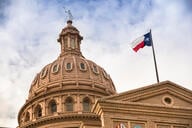You have /5 articles left.
Sign up for a free account or log in.
WASHINGTON -- You could almost hear the plaintiveness in Anthony J. Guida Jr.'s voice Thursday as he surveyed the current landscape in which politicians and others in this town are talking about how to measure quality and value in for-profit higher education.
"I'm hopeful that the policy discussion pivots soon" to one in which data and thoughtful analysis hold sway, Guida, senior vice president for regulatory affairs and strategic development for Education Management Corp., said during a panel, philosophically entitled "What Does It All Mean?," at a meeting of for-profit college officials and investors here.
Nice sentiment, but Thursday's political developments related to for-profit higher education made Guida's "Can we all just get along?" moment seem like a pipe dream.
With dueling news conferences and documents, advocates for the sector went toe to toe with the government entities and agencies that have been aggressively scrutinizing the colleges for the last 18 months, producing much more heat than light. Perhaps the most intriguing thing about the developments of this week is that, for the first time in a long while, it was slightly difficult to tell who was more on the defensive: the colleges or their government critics.
That's mostly because of Wednesday's revelation by The Washington Post that the Government Accountability Office had significantly revised the highly damaging "mystery shopper" report it produced this summer as the centerpiece of Sen. Tom Harkin's second hearing on the for-profit college sector.
The report provided videotaped and other evidence that employees at all 15 for-profit colleges visited by Congress's investigative arm had made “deceptive or otherwise questionable statements” to students about accreditation, graduation rates, employment outcomes, program costs or financial aid. And it has since been Exhibit A (if not B and C and D) of the need for tougher oversight of the industry, used not only by Harkin and his colleagues in Congress, but by Education Department officials to help justify new rules the department has proposed to zero in on commercial colleges to assess whether they are providing a meaningful and valuable education to their students.
The damaging information in the GAO report knocked career college officials back on their heels, giving credence to Democratic politicians' assertions that "bad actors" in the sector needed significantly more regulation, and implying (because the inquiry uncovered problems at all 15 of the colleges visited) that there might actually be a lot of tainted players. The report's release also, not unimportantly to some observers, drove down the companies' stock prices sharply.
Defenders of the sector minimized the significance of the report, but in recent weeks they had also stepped up their questioning of its legitimacy, going so far as to file a Freedom of Information Act request this fall seeking the raw video footage and other material behind the GAO report. The clear rationale behind that filing was that the report somehow overstated the seriousness or the extent (or both) of the bad practices implied by Harkin and Education Secretary Arne Duncan in trumpeting the report's contents.
In that context, the Post's finding that the GAO, in re-issuing the August report late last month, had softened some of its findings (though without, its officials were quick to note, altering its underlying conclusions), provided fodder to those trying to discredit, or at least raise doubts about, the influential report.
A side-by-side comparison of the two documents published by the Post shows that some of the changes are inconsequential -- an admissions official at one college telling the undercover would-be applicant that she "could" (rather than "should," in the original) "take out the maximum amount of federal loans, even if she did not need the money."
But others seem more serious. Where a finding in the original document said that an admissions representative had directly declined to disclose the institution's graduation rate when asked by the investigator (and that the college's website did not provide the rate), the corrected document drops the accusation about the official refusing to answer and simply states: "The college's Web site did not provide the graduation rate."
And perhaps most damagingly, where the original asserted that an admissions official had told the undercover applicant that the applicant would have finished the seven-month academic program before the government would be able to verify financial or other information about the applicant, the updated version acknowledged that the undercover agent himself had suggested that idea. "The representative acknowledged this was true."
While commenters on Inside Higher Ed, bloggers and others debated the significance of the changes, the shift of gears may give for-profit college advocates the seed of doubt they need to challenge the substance of the findings -- and at the very least, it appeared to embolden them to go on the attack.
On Thursday, the Coalition for Educational Success filed a lawsuit against the Education Department to try to enforce its federal request seeking information about the GAO report. The lawsuit by the coalition -- which has emerged out of nowhere to play the role of the "bad cop" while the sector's main trade group, the Association of Private Sector Colleges and Universities, lowers its volume -- also seeks information about correspondence between department officials and investors who benefit when the stocks of the for-profit colleges suffer.
“The revised GAO report validates the coalition’s concerns and may be just the tip of the iceberg in revealing a coordinated effort to demonize an industry in advance of Congressional hearings and in support of the DOE’s proposed regulations,” Lanny J. Davis, the former Clinton White House official and the public face of the Coalition for Educational Success, said in a news release about the lawsuit. He reiterated those and other comments in a telephone news conference with reporters Thursday afternoon.
Harkin Pushes Back
In a news conference of his own on Thursday, Harkin noted that "the revisions that came out did not change the conclusions [of the GAO report] one bit." But the fact that Harkin had to offer that defensive statement suggested that the release of the revised report had altered the dynamics of the debate over for-profit colleges at least a bit -- especially by raising questions about the work of Congress's well-respected investigative arm, and suggesting it might have been policitized (rather than just sloppy).
That was all the more true because Harkin's comments came during a call when he seemed to be going to extraordinary lengths to change the subject. Late Wednesday, his aides sent around notice that they would be releasing a report Thursday showing the significant upturn in the amount of federal money flowing to for-profit colleges to educate military service members and veterans.
Some of the information in the report was noteworthy -- veterans at for-profit colleges making up 23 percent of all recipients of Post-9/11 GI Bill benefits, but receiving 36.5 percent of such funds -- but none was new. Yet citing what he described as evidence the committee had produced previously showing "atrocious withdrawal rates" and "misleading recruiting practices" -- the latter a reference to the evidence from the GAO report -- Harkin characterized the disproportionate share of military financial aid going to students at for-profit colleges as yet more evidence that the institutions are abusing the public trust.
He also highlighted the case of one student veteran who said he had been misled by Kaplan University, and Don Overton, the head of a veterans' organization, Veterans of Modern Warfare, who described "the growing number of horror stories" he said he'd heard from his members about their experiences at for-profit colleges.
"It just pains me to see so much of this money going for big profits," Harkin said during the news conference. "Are [the veterans] really getting their money's worth? Taxpayers are out, and GIs aren't getting the [educational] benefits" they're expecting.
Harkin suggested that he would pursue legislation (discussed at a Senate hearing in September) that would force for-profit colleges to change how military financial aid is counted in a regulatory approach that is designed to ensure that colleges do not depend exclusively on federal money. Right now those funds are counted as money that institutions derive from sources other than the federal financial aid programs, rather than under the 90 percent cap on the proportion of their revenues they can draw from the federal student aid programs.
Two hours after Harkin's call, Davis and Harris N. Miller, who heads the association of for-profit colleges, held competing calls to play down the significance of the Harkin report's findings. Miller also trotted out two veterans of his own who'd had positive experiences at career colleges, because their local public colleges did not have convenient offerings or the capacity to serve them.
"It should be a [cause for] celebration that many more veterans and their families are going on to higher education, because of the expansion of benefits under the new GI Bill and because our colleges have made affirmative efforts to welcome them," Miller said. "This is something that should be a moment of good news in the efforts of the country to regain a position of world leadership as the No. 1 higher education country in the world." But Harkin's report "makes it seem like a bad thing," Miller said.





